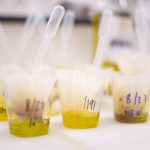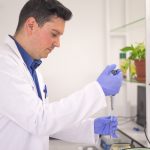MOSH and MOAH and other vegetable oil contaminants
Indlab is one of just a handful of Spanish laboratories equipped for the detection of these vegetable oil contaminants.
In addition to common heavy metals, pesticides and benzopyrenes, we are also able to detect other compounds, including MOSH and MOAH, phthalates, 2-3 MCPD esters, and glycidyl ethers.
Indlab, a laboratory specialised in vegetable oils, has studied these contaminants and has successfully applied methods for their accurate analysis. This makes us one of very few laboratories in which the sector is able to control the presence of MOSH and MOAH, 2-3 MCPD esters, glycidyl esters and phthalates, amongst other more common contaminants, such as pesticides, aromatic polycyclic hydrocarbons (benzopyrenes) and heavy metals.
Our technical expertise with regard to contaminants and residues has earned us the recognition of the International Olive Council. We are one of 7 laboratories in the world that has succeeded in demonstrating our expertise in all the areas evaluated by the IOC – advanced physical-chemical analysis, contaminants and residues, and sensory analysis.
Interest in the detection and control of these emerging contaminants on the rise in the sector.
At a commercial level, the absence of these contaminants is increasingly sought after by bottlers and importers, thus producers, exporters and other stakeholders, take all necessary precautions to avoid the presence of such materials.
MOSH and MOAH
MOSH-MOAH are mineral oils which, according to the European Food Safety Authority, are hazardous to human health. The European Union therefore recommends their monitoring and control. The contamination of vegetable oil with the compounds may be caused, amongst other reasons, by the lubricants on the machines used during the harvesting and production of the oil itself.
PHTHALATES
Phthalates are found in plastics and can contaminate the oil through the use of hoses, tubes and packaging. These compounds are used to add flexibility to plastic and are not suitable for use with foodstuffs on account of their carcinogenic potential.
2-3 MCPD ESTERS AND GLYCIDYL ESTERS
We have succeeded in applying another method for the detection of 2-3 MCPD esters and glycidyl esters. The European Union recommends the control of these compounds on account of their carcinogenic potential. Their origins can be traced back to the processing and refining of these edible oils.
Recognised by the IOC for advanced physical-chemical analysis, contaminants and residues and panel testing.
Just 7 laboratories in the world have achieved recognition in all three areas evaluated by the IOC – advanced physical-chemical analysis, sensory analysis and analysis of contaminants and residues.
The IOC now evaluates and recognises the technical expertise required for the detection of contaminants and residues.
Of the more than 20 Spanish laboratories to achieve IOC recognition in one area or another, Indlab, the public laboratories in Atarfe and Cordoba, and the Laboratory of the Ministry of Food & Agriculture, were the only three to achieve recognition in all three evaluation areas.
Basic and advanced physical-chemical analysis, analysis of contaminants and residues, and sensory analysis, are the categories under which the IOC evaluated and classified the laboratories, according to the expertise demonstrated through their working practices.
Indlab, together with the three aforementioned public bodies, were the only Spanish laboratories to demonstrate sufficient competence in all three areas evaluated by the IOC.
Spain continues to head the list of IOC awards, with over 20 laboratories officially named. 13 public and private bodies were recognised for their expertise in physical-chemical analysis, meanwhile 15 laboratories (13 public, 2 private) achieved recognition in the field of sensory analysis. Indlab was the only Spanish company to obtain recognition by the IOC in all three areas of expertise.
TABLE OF PHYSICO-CHEMICAL STUDIES REVIEWED BY THE IOC
| Basic | Advanced | Contaminants and residues |
| Acidity index Peroxide value K268/270 K232 Humidity Impurities |
Those included in A Ethyl esters Fatty acids Sterols and total sterols Biophenoles Tocopherols Spurious oils Waxes Aliphatic alcohols ΔECN42 Stigmastadiene 2-glyceryl monopalmitate Erythrodiol and uvaol Unsaponifiable matter |
Halogenated solvents Polycyclic aromatic hydrocarbons Benzopyrenes Benzoanthracene Benzofluoranthene Chysene Heavy metals Pesticide residues |








